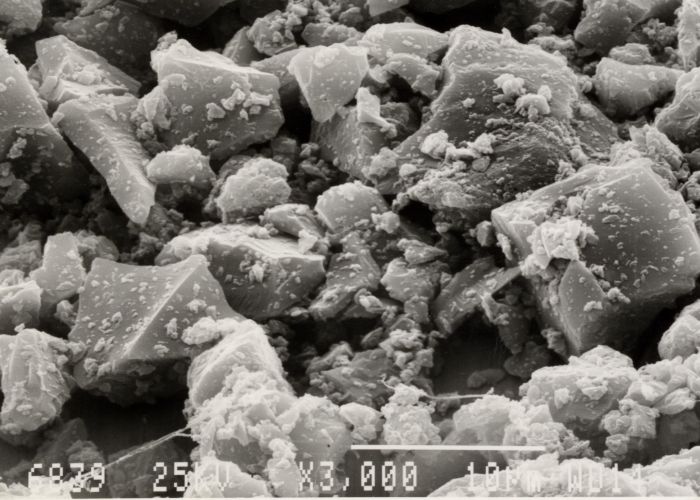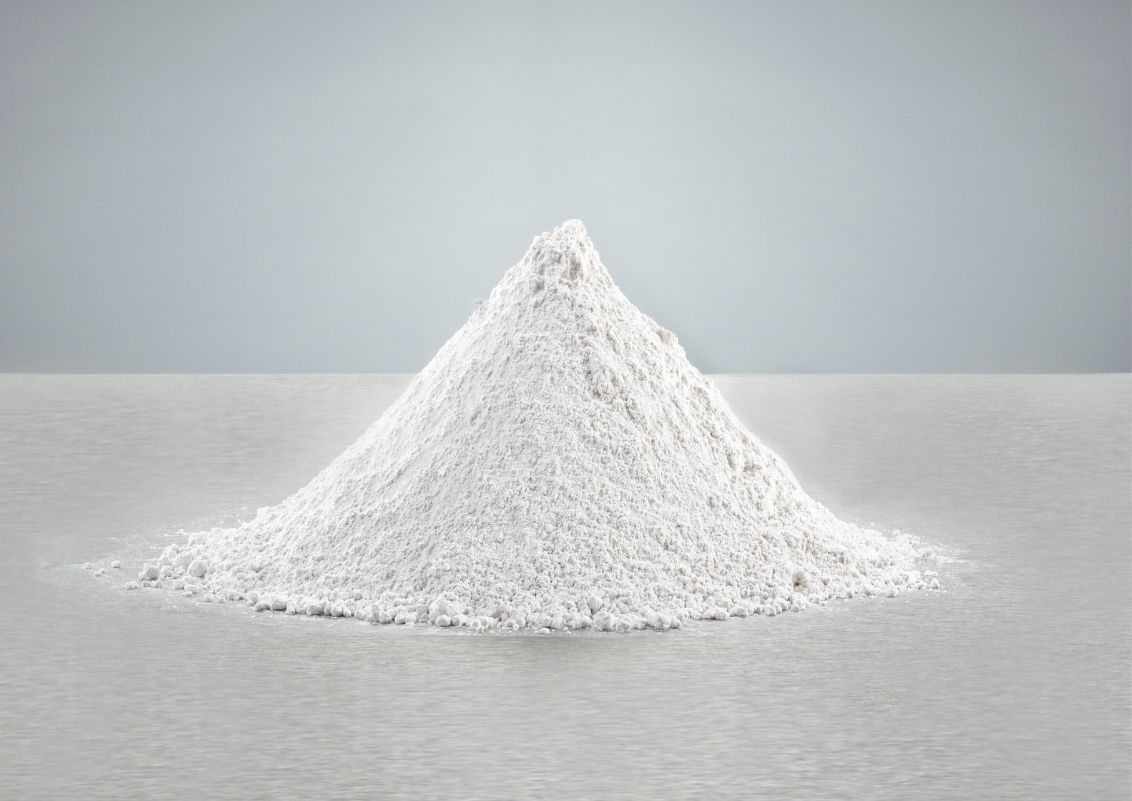Silica - A Raw Material with Many Facets
Silica – An Indispensable Element for the Industry
On our planet, there are about 4,500 types of minerals, of which only a few are common or considered petrogenetic. With a share of 12% after feldspar, silica is the second most common mineral.
It is found in igneous, metamorphic, and sedimentary rocks, as well as in deposits. In nature, silicon dioxide mainly occurs in the form of trigonal silica. As an essential raw material, silica plays a crucial role in various industrial sectors. Its versatile application extends to many industrial fields. Silica is an indispensable element in the production of glass and foundry, but also in the electrical industry – for example in the production of insulators – and of course in the production of construction chemicals.
Silica is inert and resistant to weathering, which makes it a durable material. The chemical purity of silica-based products is of fundamental importance for industrial use, as only in this way can precise processing and a variety of specific applications in different sectors be ensured.

Modification of silicon dioxide(SIO2)
The mineral group of oxides includes silica, cristobalite, and fused silica, all of which share the same chemical composition, namely SiO2. However, they differ in terms of their production, various technical parameters, and the fields of application in which they are used.
MINERALOGY
Silica belongs to the mineral class of oxides and has a trigonal crystal system. The crystal class is trigonal trapezohedral (32). As an oxide, silica is characterized by a metal-oxygen ratio of 1:2. In rock classification, the silica content as a main criterion plays a central role.

Technical Properties
-
Hardness: 7 (Mohs)
-
Density: 2,65 g/cm³
-
High chemical resistance
-
Low thermal expansion coefficient 14*10-6/K
(bei T 20 – 300°C) -
Good electrical insulation properties (low tan delta)
Silica Grain Size Distribution
The grain size distribution of silica varies depending on the origin and geological conditions during its formation. Silica can occur in various grain sizes, from very fine to coarse. In geological terminology, silica is often classified as "clastic sedimentary rock," which means that it is composed of fragments of rocks or minerals. Silica can manifest as fine grains, sand, or even coarser fragments. For industrial use, silica is washed, classified, and dried.
HPF Silica Flour: Products of the highest quality
The silica flour products distributed by HPF carry the following brands:
MILLISIL®
our coarse silica flours
SIKRON®
represents fine silica flours
SILBOND®
offers you surface-treated silica flours
Silica Flour: Many advantages in one product
Surface treated silica flours offer a range of advantages that support their application in various sectors. These include increased resistance to hot water, marked weather resistance, and enhanced chemical resistance. Additionally, they exhibit higher mechanical strength and distinguish themselves by excellent workability. Consistent colors and higher filling levels are other important advantages.
This wide range of benefits makes surface treated silica flours a versatile and highly valued material in various industrial applications.

Surface treatment of Fillers: Advantages of Surface Treatment
Several silanes have proven effective in the surface treatment of fillers. A significant advantage of direct surface treatment is that condensation by-products can escape during the coating of the mineral.
The use of coated fillers facilitates incorporation into a polymer compared to uncoated ones. To ensure optimal bonding between polymer and high-performance filler, a coating agent specifically adapted to the polymer system is required. This adaptation ensures not only better incorporation but also optimal performance of the overall composite material.
OUR SILICA – IMPORTANT RAW MATERIAL FOR POLYMER APPLICATIONS
Silica in Paints and Coatings
The use of the raw material silica in paints and industrial coatings offers numerous advantages:
- high surface hardness
- low-cost formulations
- excellent weather resistance
- improved chalking stability
Increased corrosion protection through targeted surface modification
The use of surface treated silica flours SILBOND® shows significant improvements in epoxy resin-based powder coatings for external metal coatings. These include increased corrosion protection, enhanced weather resistance, and optimized filling degrees. Additionally, the use of surface treated silica flours contributes to increased resistance to cathodic delamination.

Silica in the Industry and Construction Chemistry
Silica is also an important element in the production of the following construction materials:
- Dispersion plasters
- Colored plasters
- Silicate plasters
- Mineral plasters
Epoxy Resins for Electrical Applications
Epoxy resins also have a significant role as a raw material in electrical engineering due to their excellent adhesion, heat and chemical resistance, and excellent electrical properties. They can be used in the construction of transformers and the production of insulators and dry transformers.
The mechanical, thermal and electrical properties of epoxy resins are strongly influenced by the functional filler used.
Advantages of Silica Flour in Epoxy Resin Applications
- Improved weather and chemical resistance
- Good mechanical strengths
- Excellent workability
- Low thermal expansion
- Reduced shrinkage
- High filling degrees
Silica as a Raw Material in Engineered Stone
Silica is also used in engineered stone applications, such as countertops and kitchen sinks. Additionally, the use of coarse silica grains in the polymer allows the reproduction of natural stone.
Silica Flour in Silicone
Silicone stands out for its unique properties: it is extremely elastic, has high heat resistance, is hydrophobic, and exhibits impressive dielectric resistance.
Compared to types of organic rubber, silicones maintain their exceptional properties over a wide temperature range. This resistance makes silicones preferred materials for thermally demanding applications such as seals, insulations, and molded parts. In fields such as medical technology, the electronics industry, and household applications, silicones have become indispensable due to their unique characteristics.
Advantages of Silica Flour in Silicone Applications
- Adjustable elasticity or Shore hardness
- Electrical insulation properties
- Reduced reaction shrinkage

The fascinating properties of Silica
Silica reveals a range of unique properties. In the form of thin lamellae of pure rock crystal, it shows the ability to oscillate at a constant frequency. Silica has a right-handed or left-handed molecular structure along the optical axis, which leads to rotation of the incident light.
Inert to most substances, silica reacts only with hydrofluoric acid or soda fusions. The variety of colors that silica can assume – from transparent to white, to yellow, purple, and more – gives it a wide range of aesthetics. Resistance to thermal shock and the high degree of pure transmission make silica a versatile and sought-after mineral in various fields of application.
Production and Industrial Use of Silica
The industrial use of silica depends heavily on extensive and exploitable quartz sand deposits. A significant source is found, among others, in Frechen, near Cologne.
However, chemical purity and homogeneity alone are not sufficient to use silica directly as a raw material. Quartz sands must undergo thorough processing, including complex washing, classification, drying, and iron-free grinding processes. This process yields quartz sands, quartz flours, and fine quartz flours. Specifically, to produce quartz flours and fine quartz flours with precisely defined grain sizes, iron-free grinding processes and separation processes are also necessary.
An additional refining step consists of targeted surface modification, specifically adapted to the application. This can be achieved, for example, using silanes or silane-based substances.
The History of Silica
-
Already in antiquity, silica was used for various purposes. The ancient Egyptians used rock crystal for jewelry and ritual objects. In ancient Greece, the term "krystallos" was used for ice, indicating that the Greeks associated the transparent properties of silica with frozen water
-
During the Middle Ages, the use of silica in alchemy became significant. With the advancement of science in the 17th century, a better understanding of mineralogy was achieved, and the nature of silica was studied more accurately.
-
In the 18th and 19th centuries, technological advances led to an increasing use of silica in the industry. The discovery of the piezoelectric effect of silica in the 1880s provided the basis for the development of quartz clocks; however, the first quartz clock was presented only in 1927 by Bell Laboratories.
-
In the following decades, silica became increasingly important in various technological applications, including electronics and telecommunications. For example, in the 1970s, quartz clocks conquered the mass market.
-
The founders of Quarzwerke GmbH in Frechen had already recognized the invaluable value of this mineral in 1884 and built the company on it.
Today, silica is indispensable in numerous industrial sectors. From electronics to construction, to medicine and the beauty industry, silica plays a fundamental role thanks to its versatile properties.
FAQ
What is silica?
Silica is a stable form of silicon dioxide (SiO₂) and, after feldspar, the second most common mineral in the earth's crust. It is found in igneous, metamorphic, and sedimentary rocks and plays a crucial role in various industrial sectors.
In which industry is silica used?
Silica finds applications in numerous industries, including:
- Glass production
- Foundry industry
- Electrical industry (e.g., in the production of insulators)
- Construction
What does surface treatment of silica mean and why is it important?
Surface treatment of silica improves the adhesion between silica and the surrounding material. This is particularly relevant in polymer applications to enhance the mechanical properties and durability of the final product.
How does surface treatment of fillers affect industrial applications?
It optimizes the compatibility of fillers with polymers and significantly improves the properties of final products. It leads to more durable materials with greater stability and reliability and is therefore a key process in the production of innovative materials for demanding applications such as construction, electronics, and vehicle construction.
MORE INFORMATION?
For all questions regarding silica, we are happy to assist you at any time. Please do not hesitate to contact us – we will gladly respond.






